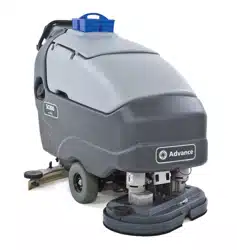Loading ...
Loading ...
Loading ...

Service Manual: SC750, SC800, SC 750 ST, SC800 ST
Form Number 56043150 Page 144
Drive Motor Controller Outputs
The primary job of the Drive Motor Controller is to operate the electric transaxle drive motor. It does this by regulang
current ow through the drive motor to control speed, and by changing polarity to control direcon. The secondary job is
to nofy the Main Machine Controller when the machine is moving and which direcon it is moving. The Main Machine
Controller uses this informaon to start and stop the soluon ow and scrub funcons.
To move the machine forward, the controller connects terminal M2 to baery negave AND connects terminal M1 to
baery posive. To regulate the speed, the controller pulses the baery posive voltage out to terminal M1 at a xed
frequency called a “duty cycle”. The greater the percentage of “on” me that the circuit is connected to baery posive,
the faster the machine will go.
To move the machine in reverse, terminal M1 is connected to ground and terminal M2 is pulsed to baery posive volt-
age. The speed in reverse is intenonally reduced.
The Drive Motor Controller tells the Main Machine Controller when the machine is moving and what direcon it is mov-
ing. Two circuits are used for this purpose, the FOR/REV and the REV circuit. Here is how the FOR/REV circuit works: The
Main Machine Controller sends 24 volts out through an internal resistor to the Drive Motor Controller. The Drive Motor
Controller has an internal switch to baery negave (B-). When the machine is not moving, the switch is open. There
is an internal voltmeter inside the Main Machine Controller that sees 24 volts on the circuit. When the machine moves
in either direcon, the switch closes and the voltage drops to 0 volts. This tells the main machine controller that the
machine is moving. However, the main machine controller does not know what direcon the machine is moving. There
is another circuit called the REV circuit that provides direcon informaon. It works similar to the FOR/REV circuit. When
the machine is staonary or moving forward, the switch remains open so the main machine controller “sees” 24v. The
switch closes when the machine moves in reverse, dropping the voltage to 0v.
• Staonary Machine - Both Inputs=24v
• Machine Moving Forward = FOR/REV=0v, REV = 24v
• Machine Moving in Reverse - FOR/REV=0v, REV = 0v
Loading ...
Loading ...
Loading ...
